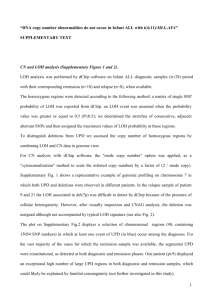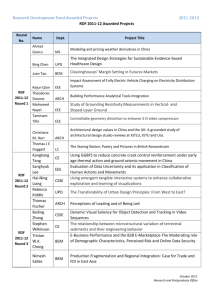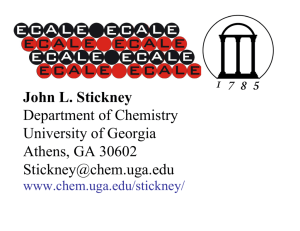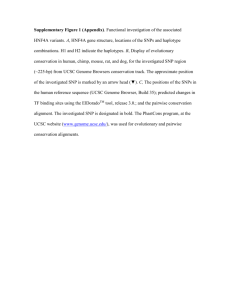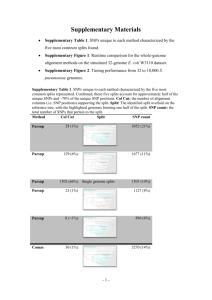Supplementary Figures and Table Legends (doc 3916K)
advertisement
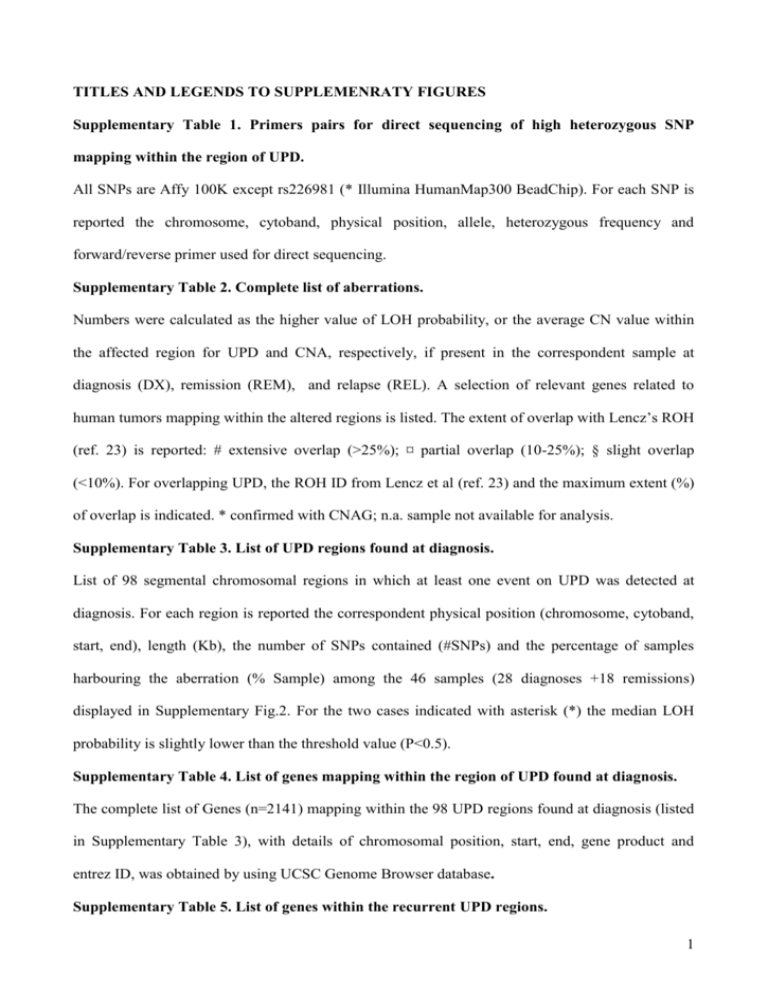
TITLES AND LEGENDS TO SUPPLEMENRATY FIGURES Supplementary Table 1. Primers pairs for direct sequencing of high heterozygous SNP mapping within the region of UPD. All SNPs are Affy 100K except rs226981 (* Illumina HumanMap300 BeadChip). For each SNP is reported the chromosome, cytoband, physical position, allele, heterozygous frequency and forward/reverse primer used for direct sequencing. Supplementary Table 2. Complete list of aberrations. Numbers were calculated as the higher value of LOH probability, or the average CN value within the affected region for UPD and CNA, respectively, if present in the correspondent sample at diagnosis (DX), remission (REM), and relapse (REL). A selection of relevant genes related to human tumors mapping within the altered regions is listed. The extent of overlap with Lencz’s ROH (ref. 23) is reported: # extensive overlap (>25%); ¤ partial overlap (10-25%); § slight overlap (<10%). For overlapping UPD, the ROH ID from Lencz et al (ref. 23) and the maximum extent (%) of overlap is indicated. * confirmed with CNAG; n.a. sample not available for analysis. Supplementary Table 3. List of UPD regions found at diagnosis. List of 98 segmental chromosomal regions in which at least one event on UPD was detected at diagnosis. For each region is reported the correspondent physical position (chromosome, cytoband, start, end), length (Kb), the number of SNPs contained (#SNPs) and the percentage of samples harbouring the aberration (% Sample) among the 46 samples (28 diagnoses +18 remissions) displayed in Supplementary Fig.2. For the two cases indicated with asterisk (*) the median LOH probability is slightly lower than the threshold value (P<0.5). Supplementary Table 4. List of genes mapping within the region of UPD found at diagnosis. The complete list of Genes (n=2141) mapping within the 98 UPD regions found at diagnosis (listed in Supplementary Table 3), with details of chromosomal position, start, end, gene product and entrez ID, was obtained by using UCSC Genome Browser database. Supplementary Table 5. List of genes within the recurrent UPD regions. 1 The complete list of Genes (n=187) mapping within the 20 regions of recurrent UPD found at diagnoses (listed in Table 3), with details of chromosomal position, start, end, gene product and entrez ID, was obtained by using UCSC Genome Browser database. Supplementary Figure 1. Example of CNA and UPD in a representative chromosome. Example of CN and LOH analysis performed by dChip on chromosome 7. Black arrows represent segmental CN-neutral LOH regions (i.e. UPD(7)(q21.11) in pt.2 at REL, UPD(7)(q21.3q32.3) in pt.9 at DX, REM and REL, UPD(7)(q31.33q32.1) in pt.11 at DX and REL), green arrows represent CN loss (i.e. del(7p) in pt.9 and 22 at REL, del(7)(q11.21) in pt.14 at DX) and red arrows represent CN gain (i.e. amp(7q) in pt.21 and 22 at REL). Pt.21 and 22 display an Iso(7q) at REL. Supplementary Figure 2. Regional LOH analysis. Graphic visualization of LOH analysis performed by dChip on Infant ALL diagnostic samples (n=28) paired with their corresponding remission (n=18), when available. The plot shows a selection of chromosomal regions in which at least one event of LOH with CN neutral (segmental UPD) occurred among the diagnoses. Rows represent chromosome regions and columns represent samples. Paired diagnosis (DX) and remission (REM) are indicated for each patient. Based on SNP data 98 chromosome regions were found (on the left), containing 15054 SNP markers. The LOH probability is displayed ranging from blue (1) to white (0.5) to yellow (0). Supplementary Figure 3. UPD(14)(q21.2). A: SNP 100K calls of 4 Infant ALL patients (pt.3,4,8 and 21) compared with 6 normal infants (CNTRL1-6). DX: diagnosis; REM: remission; REL: relapse. SNP physical position deriving from GTYPE raw data refers to hg18 annotation B: Numbers indicates the higher probability of LOH within the region among the affected patients in their corresponding samples at DX, REM and REL. The samples indicated with asterisk (*) were detected exclusively with CNAG software. n.a. samples not available C: The segmental UPD was confirmed with CNAG (one representative case is shown) D: The homozygous status of 4 SNPs (labelled in red in panel A) with high heterozygous frequency in the 4 Infant ALL cases was validated by sequencing. 2 Supplementary Figure 4. UPD(7)(q31.22q32.1). A: SNP 100K calls of 3 Infant ALL patients (pt.1,9 and 11) compared with 6 normal infants (CNTRL1-6). DX: diagnosis; REM: remission; REL: relapse. SNP physical position deriving from GTYPE raw data refers to hg18 annotation. B: Numbers indicates the higher probability of LOH within the region among the affected patients in their corresponding samples at DX, REM and REL. n.a. samples not available C: The segmental UPD was confirmed with CNAG (all the three cases are shown). The red box indicates the minimal common region. D: The homozygous status of 4 SNPs (labelled in red in panel A) with high heterozygous frequency in the 3 Infant ALL cases was validated by sequencing. Supplementary Figure 5. UPD(8)(q21.13). A: SNP 100K calls of 2 Infant ALL patients (pt.19 and 21) compared with 6 normal controls (CNTRL1-6). DX: diagnosis; REM: remission; REL: relapse. SNP physical position deriving from GTYPE raw data refers to hg18 annotation. B: Numbers indicates the higher probability of LOH within the region among the affected patients in their corresponding samples at DX, REM and REL. n.a. samples not available C: The segmental UPD was confirmed with CNAG (one representative case is shown) D: The homozygous status of 4 SNPs (labelled in red in panel A) with high heterozygous frequency in the 2 Infant ALL cases was validated by sequencing. Supplementary Figure 6. UPD(8)(q24.11). A: SNP 100K calls of 2 Infant ALL patients (pt.2 and 9) compared with 6 normal controls (CNTRL1-6). DX: diagnosis; REM: remission; REL: relapse. SNP physical position deriving from GTYPE raw data refers to hg18 annotation. B: Numbers indicates the higher probability of LOH within the region among the affected patients in their corresponding samples at DX, REM and REL. n.a. samples not available C: The segmental UPD was confirmed with CNAG (both cases are shown). The red box indicate the minimal common region. D: The homozygous status of 4 SNPs (labelled in red in panel A) with high heterozygous frequency in the 2 Infant ALL cases was validated by sequencing. 3
